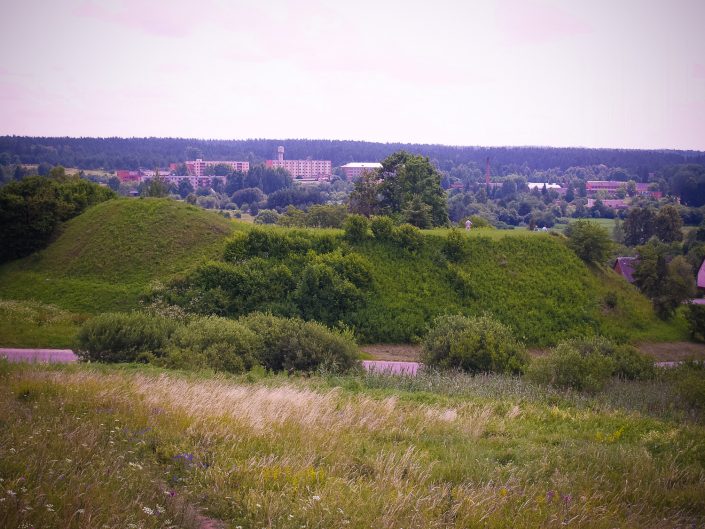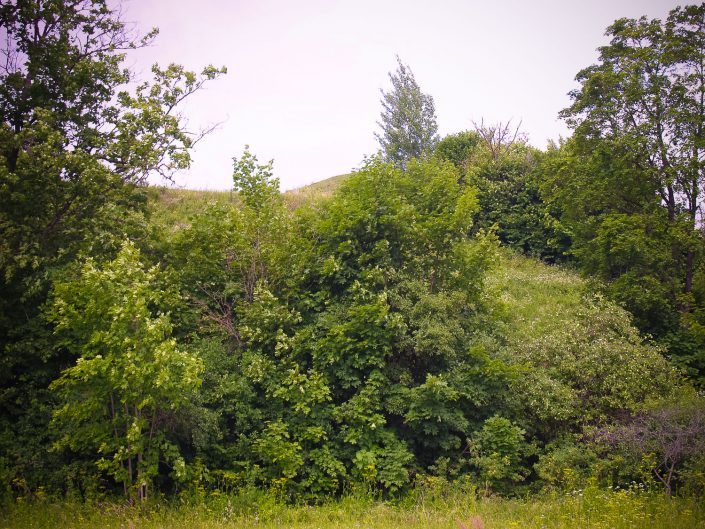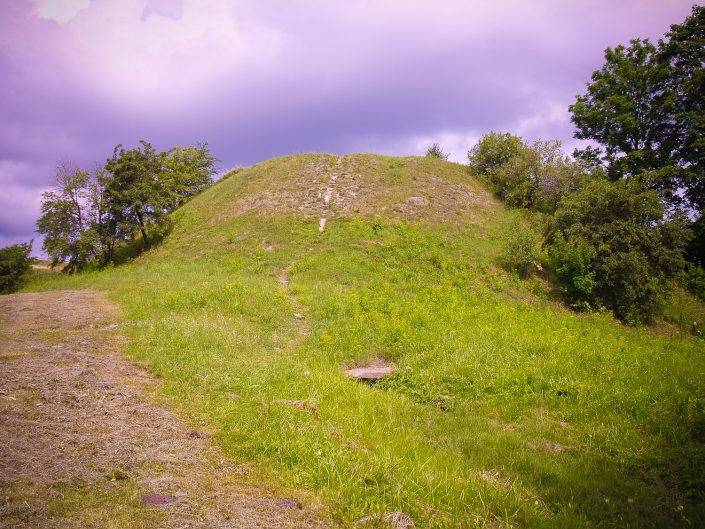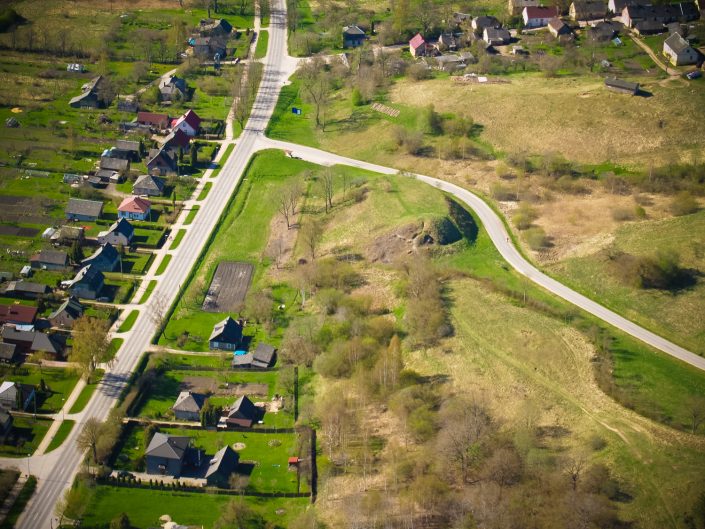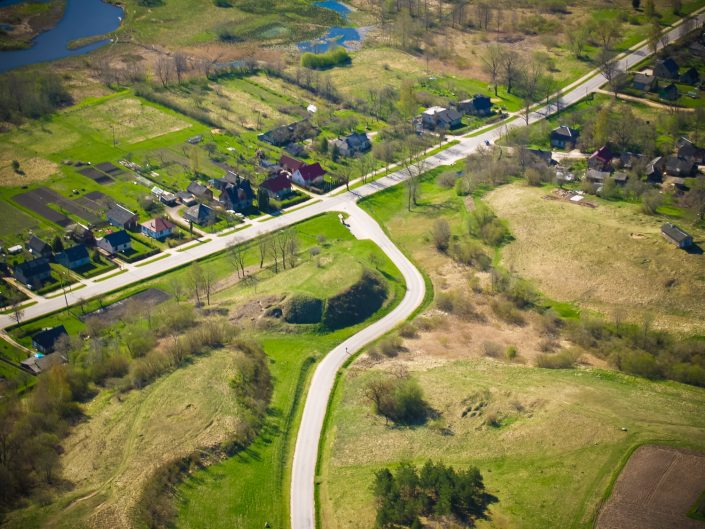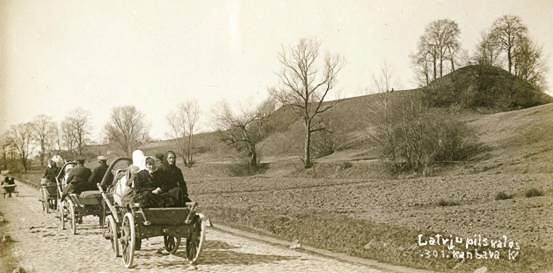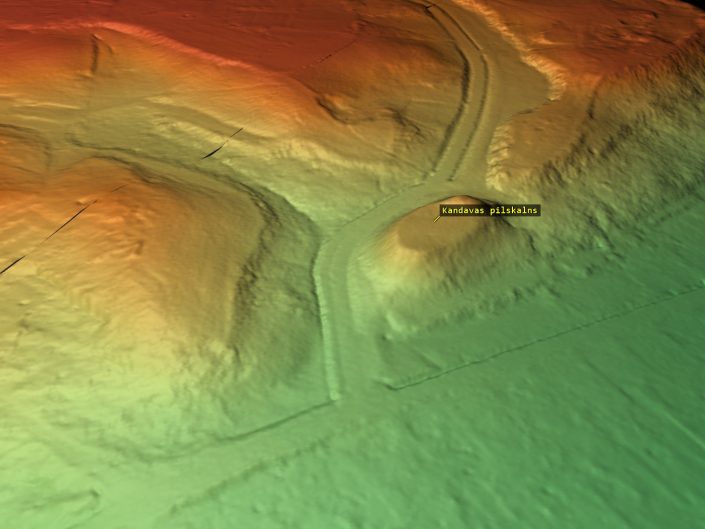Location
State: Latvia
Region: Riga
Town: Kandava
Other references to the location
In the N part of Kandava at Abavas street. Bending around the S end of the Church Hill, at the edge of the Abava old vale, up goes Raiņa street. Address – 2 Pūzurgravas Street.
Coordinates
lat=57.0408333333, lon=22.7830555556
57° 2′ 26″ N, 22° 46′ 59″ E
Description
The Kandava Hill Fort is located in the northern part of Kandava town by the Kandava – Tukums highway between two lowlands. The first plan of the Hill Fort was published by F. Kruze in the publication “Necrolivonica” in 1842, but its first more detailed description was made by A. Bīlenšteins in 1869. The hill, which has artificially elevated edges all around it, is oriented in N – S direction; its plateau is 40 x 26 m large, but the height is from 8 to 10 m above the surroundings. In the N part, the Hill Fort is detached by a three meters high rampart, in front of which there is a ditch. In the Hill Fort’s plateau, there was about 1 m deep intensive cultural layer established. Kandava was mentioned in written sources for the first time in 1230, so it is presumed that the Hill Fort had been inhabited until the 13th century. The name Baznīckalns (the Church Hill) is explained by people in two ways: 1) the hill’s silhouette with the high rampart resembles the silhouette of a church; 2) a church sank into the hill. Due to its composition and presence of the cultural layer, the Kandava Church Hill is considered to be a typical hill fort, although due to the mythological tales about the sunken church it can be considered to be a place related to sacrality. Other tales about the Kandava Church Hill are typical tales about hill forts. Along the S slope of the hill, a path leads upwards, which used to have steps decayed now. The path goes across the Hill Fort’s plateau, over the rampart and then along the rampart’s slope downwards again, where at the lower part of the rampart there was a groundslid once. The slope of the Hill Fort against Abavas Street is more and more overgrowing by bush and there it is starting gradually to lose its great picturesque value. On the opposite side, the slope of the hill was mown years ago, but now tree offsprings are starting to grow again, which, nevertheless, are not yet substantially affecting the great visual image of the Hill Fort. The Hill Fort’s plateau has been mown, but it still has quite a lot of littered garbage. The cultural layer, being of a dark colour, can be well perceived at the S foot of the Hill Fort and in the plateau; closer to the rampart, the cultural layer becomes less intensive and it contains more pieces of limestone.
Narrative
1) “Just like there is a knights’ hill fort in Kandava, there is also an ancient Latvian hill fort. It is located a little bit outside Kandava by a road leading to the Kandava station. This hill fort resembles a wholly split off cone. Only at the top of the hill, there is one more hillock. People say that there once a church had sunk. That is why people call it also the Church Hill. A path leads upwards to the top of the hill. Along the sides of the hill, there are bushes and several lindens growing. Several linden trees and other trees are growing on the hillock too. This is how approximately the ancient Latvian hill fort looks like in Kandava.” (Latvian Folklore Repository (hereinafter referred to as “LFK”) 623, 26. Recorded in Kandava. Latvian Folk Tales. Historic Tales. Selection. Compiled by A. Ancelāne. – Riga, Zinātne, 1988, p. 52) 2) “The Church hill by Kandava. By Kandava, they say, there is a church hill, where in former times there was a church, which had sunk once. And at the very top of the tower, they say, one hole has remained only. A duck was let in there and downwards the Abava appeared.” (LFK 913, 457. Recorded by Jānis Jansons, Tl Zentene Balgale Elementary School 3rd form.) 3) “Once there used to be a lofty castle and a large church. Underground, there were many passages and cellars. When enemies attacked, the castle was pulled down into the cellars, but when the enemies retreated, the castle was pulled up again. Once the bitter enemy, the German, attacked, the castle sank and never came out again. When you listen on Sunday mornings, you can hear the church bells ring. When climbing the Church Hill, you can see a cavity, there the castle sank. People let a duck into the cavity and the Abava appeared. The Church Hill is located in Kandava.” (LFK 974, 14. Kandava, recorded by Jānis Odziņš 1930. Latvian Folk Tales. Historic Tales. Selection. Compiled by A. Ancelāne. – Riga, Zinātne, 1988, p. 52.) 4) […] Bielensteins confirms that the Latvians call the hill as the Hill Fort, but the Germans – the Monastery Hill or Church Hill. […] Some other tale was recorded by A. L. Puškaitis: “Once on Sunday the church sank into the ground of the Church Hill with its priest and churchgoers.” (“Balss”, 1891; E. Brastiņš. Latvian Hill Forts. I. Kurši Land. – Riga, Vālodze, 1923, p.40)
Attraction
Attractive
Availability
Easily accessible, at the verge of the street
Infrastructure, management, facilities
Facilitated infrastructure, located at the verge of the street within the territory of the town.
Local info
None
Capacity
41 and more
Publicity
Popular
Legal Status
Property of State
Comments
At Raiņa and Abavas Street, there is a small parking lot facilitated with benches and an information stand installed about tourism objects in Kandava County, where the Kandava Hill Fort is mentioned in general, although otherwise the Kandava Church Hill is not described or pointed out and unaware persons might not understand that they find themselves at the foot of a prominent hill fort.
